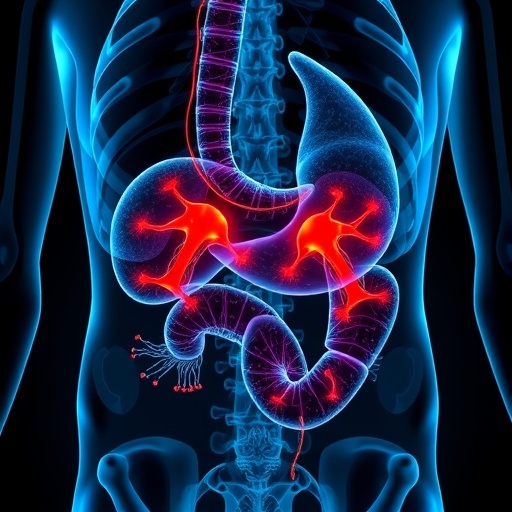Recent advancements in neuroscience have increasingly emphasized the intricate connectivity within the brain’s cortical layers, yet a full understanding of the synaptic organization within key neuronal populations remains elusive. A groundbreaking study led by Bodor, Schneider-Mizell, Zhang, and colleagues, recently published in Nature Neuroscience, sheds unprecedented light on the synaptic architecture of layer 5 thick tufted excitatory neurons (L5 TTs) in the mouse visual cortex. This research offers a detailed and comprehensive map of the excitatory and inhibitory inputs to these critical neurons, elucidating the cellular bases underlying cortical processing and the computational capabilities of layer 5 pyramidal cells.
Layer 5 thick tufted neurons represent a pivotal subclass of excitatory pyramidal neurons situated deep within the neocortex. These neurons are renowned for their extensive dendritic trees, particularly the prominent apical tufts that reach layer 1, where they integrate diverse inputs. Despite their importance in sensory processing, motor outputs, and long-range cortical communication, the precise synaptic organization governing their integrative function has remained largely unknown. The study by Bodor et al. confronts this challenge by deploying cutting-edge connectomic techniques to reconstruct the synaptic landscapes of L5 TTs at an unprecedented resolution.
Employing volumetric electron microscopy combined with sophisticated computational segmentation, the authors generated high-resolution three-dimensional reconstructions of L5 TTs within the binocular region of the mouse primary visual cortex (V1). This approach enabled the identification and classification of thousands of synapses as well as their presynaptic partners. The exhaustive reconstructions allowed the team to dissect the spatial and functional distribution of inputs onto both basal and apical dendritic compartments, revealing distinct patterns of excitatory and inhibitory innervation that converge to shape neuronal output.
.adsslot_T2GRkH1mpn{width:728px !important;height:90px !important;}
@media(max-width:1199px){ .adsslot_T2GRkH1mpn{width:468px !important;height:60px !important;}
}
@media(max-width:767px){ .adsslot_T2GRkH1mpn{width:320px !important;height:50px !important;}
}
ADVERTISEMENT
One of the most remarkable findings of this study is the delineation of synaptic input diversity across the dendritic arbor of L5 TTs. The proximal basal dendrites receive a preponderance of local excitatory inputs—likely originating from nearby pyramidal neurons in the same cortical column—coupled with dense inhibitory contacts from parvalbumin-expressing interneurons. These findings underscore the critical role of perisomatic inhibition in regulating spike generation and output precision within the neuronal network. In contrast, the distal apical tuft compartment was shown to integrate sparser excitatory synapses predominantly from long-range cortical and thalamic sources, coupled with inhibitory inputs biased towards somatostatin-positive interneurons.
The spatial segregation of inhibitory subtypes onto different dendritic domains reveals a sophisticated mechanism for modulating the gain and selectivity of L5 TT responses. Parvalbumin-positive interneurons appear specialized in targeting the soma and proximal dendrites to tightly regulate action potential initiation, whereas somatostatin-positive interneurons modulate dendritic integration zones, influencing synaptic plasticity and long-range input processing. This synapse-specific inhibition adds a new layer of complexity to our understanding of cortical microcircuit computations and underscores the multifaceted control of pyramidal neuron excitability.
Bodor et al.’s integrative analysis also demonstrated that the synaptic connectivity landscape varies not only by dendritic domain but also according to the cell type of the presynaptic partner. Excitatory synapses from neighboring L5 pyramidal neurons formed frequent reciprocal connections, contributing to recurrent excitation and amplification of sensory signals. Simultaneously, inhibitory networks provided inhibitory feedback loops critical for maintaining network stability and preventing runaway excitation. The interplay between excitation and inhibition along the dendritic arbor enforces a finely balanced dynamic crucial for reliable sensory perception.
Another compelling dimension of this research is the quantification of synapse size and ultrastructural features across different dendritic compartments. The authors reported systematic differences in synaptic contact size, vesicle density, and postsynaptic density morphology, which correlate with synaptic strength and efficacy. Larger synapses with prominent postsynaptic densities tended to reside on basal dendrites, suggesting heightened integration power for local inputs, whereas smaller but strategically positioned synapses predominated in the distal apical tuft. These structural nuances likely reflect an evolutionary adaptation for optimizing signal integration at multiple processing scales.
Importantly, the study leverages the mouse visual cortex as a model to infer organizing principles applicable across mammalian neocortex. While sensory modalities and behavioral demands may shape specific microcircuit configurations, the canonical synaptic arrangement elucidated here affirms common motifs underlying cortical computation. Layer 5 thick tufted neurons, despite their diverse projection targets and functional roles, adhere to a conserved synaptic blueprint that balances local and long-range excitation with compartmentalized inhibitory control.
The implications of these results extend beyond basic neuroscience, providing a crucial foundation for interpreting circuit dysfunctions in neurological and psychiatric disorders. Aberrant synaptic connectivity in L5 pyramidal neurons has been linked to conditions such as epilepsy, schizophrenia, and autism spectrum disorders. By establishing normative synaptic architectures with cellular precision, Bodor et al. offer benchmarks against which pathological alterations can be compared, potentially guiding therapeutic interventions aimed at restoring synaptic balance.
Furthermore, this study sets a new standard for connectomic analyses, illustrating how multidimensional data integration—from ultrastructural features to cell-type specificity—can unravel the complex organizational logic of cortical circuits. The combination of large-scale electron microscopy and computational modeling embodies the emerging frontier in neuroscience, where detailed wiring diagrams merge with functional hypotheses to generate predictive maps of brain activity.
Looking ahead, the research opens avenues to explore dynamic aspects of synaptic connectivity, such as plasticity mechanisms under sensory experience or learning paradigms. The static anatomical snapshot offered here invites further investigation into how these synaptic configurations adapt over time or disease progression. Future studies may also integrate physiological recordings and optogenetic manipulations to directly link identified synapse types with neuronal response properties and behavior.
The rich distribution of inhibitory inputs also sparks questions about interneuron diversity and their circuit-specific roles. How distinct inhibitory neuron subpopulations coordinate to regulate pyramidal cell output remains an active area of inquiry. The detailed synapse-type maps from this study provide a foundational atlas to guide targeted manipulations of specific inhibitory circuits, advancing our grasp of microcircuit function.
In summary, the unprecedented synaptic reconstruction of layer 5 thick tufted excitatory neurons provided by Bodor, Schneider-Mizell, Zhang, and colleagues represents a landmark achievement in systems neuroscience. Their meticulous characterization of input patterns, synapse ultrastructure, and inhibitory compartmentalization reveals the exquisite architectural design underlying cortical computation. This work not only enhances our understanding of fundamental brain circuits but also establishes a critical framework to decipher neural coding in health and disease. As techniques evolve, such comprehensive connectomic mappings will continue to revolutionize our insights into the brain’s complex wiring and emergent functions.
Subject of Research: The synaptic architecture of layer 5 thick tufted excitatory neurons in the mouse visual cortex.
Article Title: The synaptic architecture of layer 5 thick tufted excitatory neurons in mouse visual cortex.
Article References:
Bodor, A.L., Schneider-Mizell, C.M., Zhang, C. et al. The synaptic architecture of layer 5 thick tufted excitatory neurons in mouse visual cortex.
Nat Neurosci (2025). https://doi.org/10.1038/s41593-025-02004-2
Image Credits: AI Generated
Tags: computational capabilities of cortical neuronsconnectomic techniques in neurosciencecortical processing mechanismsdendritic tree structure in neuronsexcitatory and inhibitory inputsexcitatory pyramidal cell connectivitylayer 5 thick tufted neuronsmouse visual cortex researchneuronal population studiessynaptic architecture mappingsynaptic organization in neocortexvolumetric electron microscopy applications






